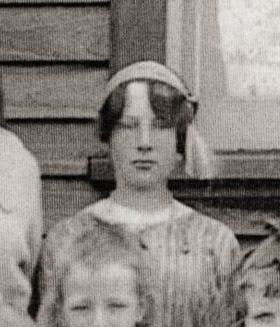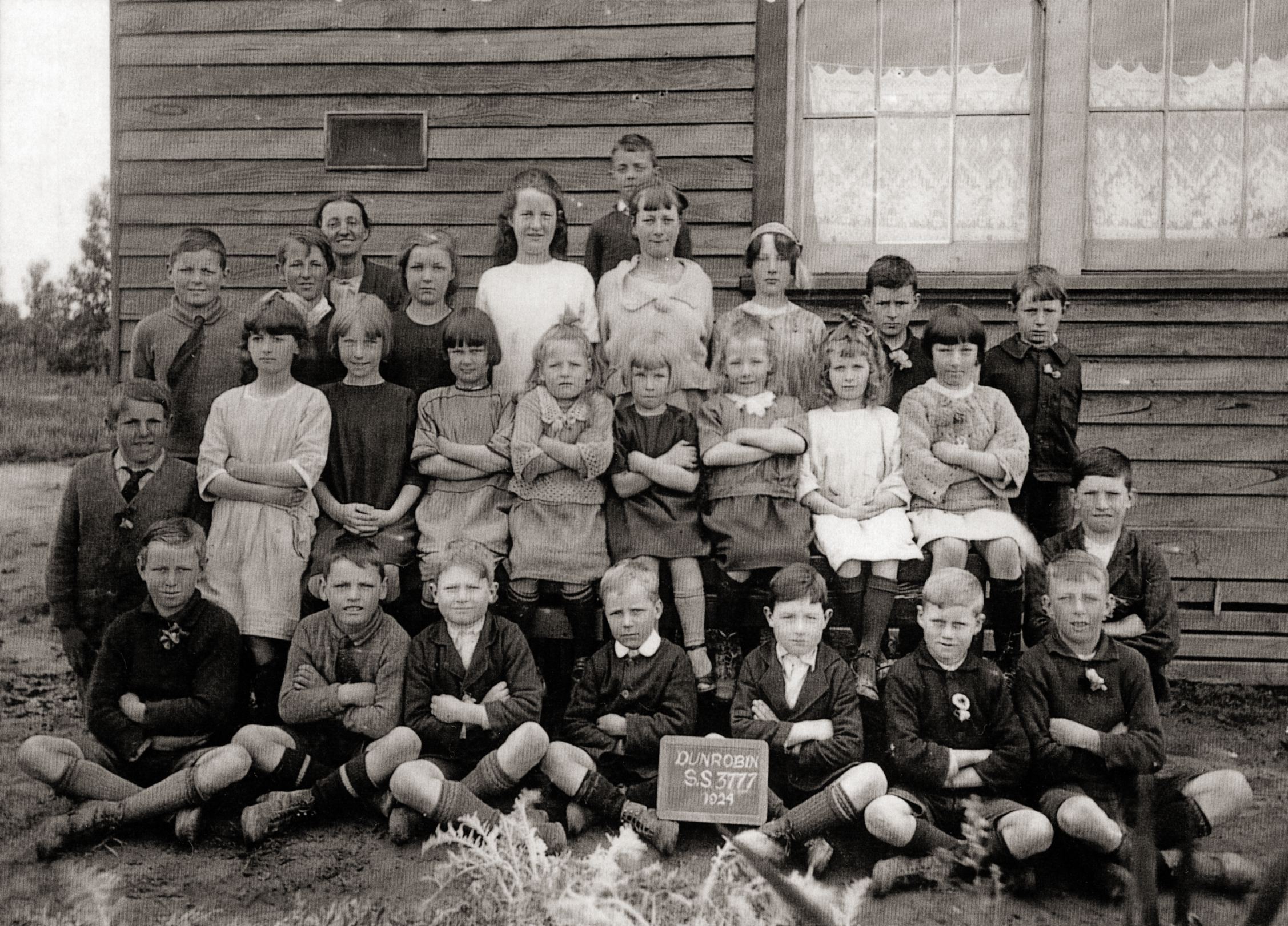1924: Post Mortem Class Picture
The Legend:
This is the class photo of the Dunrobin State School No. 3777, near Casterton, South Western Victoria, Australia, class of 1924. Notice something odd? Specifically, the lack of smiles? This was due to a rather unfortunate circumstance that had occurred the day before; one of the school children had died, a girl by the last name of Howlett. As you may well imagine, this would have been quite a damper on the general school spirit... of course, that's not the only problem these kids had to deal with. Because someone, somewhere, decided that despite the fact the girl died, she should be included in the class photo. So one of the children you are looking at is actually dead, propped up for the picture... which is a even bigger damper on the ol' school spirit, I'll tell you what!
The girl in question, Miss Howlett, is this young lady with the scarf on her head...

...which, as it turns out, is not a fashion statement. It's there to tie her head to a plank hidden behind her head so it stays up for the picture. And we know all of this is true because the picture of the class from the year before 1924 shows normal, smiling children... and the only reason a child wouldn't smile for a class photo is because someone in the shot is dead, right?
Right?
Evidence Required
This legend seems to have first made the rounds in 2013, largely after it was posted on the Paranormal Guide website [Link Here]. This site appears to be the starting point of the legend for a few reasons I will discuss in a moment... but first, allow me to lay out the sum total of the evidence provided for the truth of this story.
Ahem... NONE.
The author of the article states that Miss Howlett died a day earlier, and that there are no records explaining how. We are told this is the reason for her blank expression, as well as the appearance of the others -- "not a genuine smile to be seen" (ignoring the teacher, but you'd expect a teacher to smile when a student dies, right?). They also state that there is a wooden plank behind the girl, tied to her head by the scarf... but the plank is completely non-visible (and so unprovable), and that this is why the other children look uncomfortable and morose, especially the ones closest to the dead girl.
Past that, the author states that it was not unusual for photographs to be taken of dead loved ones "back in the days of old," in order to have a keepsake or memory of the dead family member, especially since "back in the day, photos were not anywhere near as common as they are today."
A moment, please. In the early days of photography, it was in fact a common practice to take pictures of a dead family member rather than a live one for two reasons; first, photographs were still pretty pricey, so more for special occasions than everyday use, and second, they took a long time. A loooong time. Upwards of ten to twenty minutes for a portrait, which is hard to sit for. This meant three things. One, few people smiled for a portrait, because it's hard to hold a smile for ten plus minutes. Two, photographers used hidden clamps to hold people's heads still so they wouldn't move during the portraits and blur the pictures. And three... dead people photographed really well because they wouldn't move, no matter how long the camera took to take the picture. So a one time picture of a child or loved one taken just after they died made good sense as a keepsake, but this practice itself died off as exposures became easier and cheaper to take.
By 1916, box cameras took exposures of around one-second, and were reasonably priced for the home enthusiast, so there were a lot of them... and most people in pictures could now smile, because it was quick to take a picture. By 1924, it would be very unusual to take a picture of a dead person as a keepsake, comparatively speaking. And even "back in the days of old" -- which would be around 1860-1880 -- it would be very unusual to park a dead person in a crowd of unrelated people and ask everyone to smile. But I digress.
After the author of the Paranormal Guide article presented their circumstantial claims (which is treated as if evidence existed), the author sums up the nature of the account itself by stating "there is no proof either way for or against the facts of this story"... which in no way makes it sound like there is proof for the claims made.
So let's consider the possible evidence against the claims made.
The Original Source
The main picture above of the Dunrobin State School No. 3777 class of 1924, as well as pictures of the class of 1923 (with smiling children), originate with a website that posted them in an attempt to get the members of these classes identified [Link Here]. The site is called Glenelg & Wannon Settlers & Settlement, and is focused on gathering and sharing information on early families that settled in the Glenelg and Wannon Valleys in south-west Victoria, Australia.
The pictures were posted on the site at least as early as March 2012, and so were well available before the legend was created. It's almost certain that the 2013 'Post Mortem Class Photo' article in the Paranormal Guide copied the pictures from this particular website initially, as shown by the fact that the Paranormal Guide article also borrowed quite a bit of information regarding the land the school was built on straight from the text of the school's webpage.
Additional evidence that the author of the 'Post Mortem Class Photo' saw this website is that the picture of the class of 1924 also includes notes from a piece of paper found with the photo that identifies some of the students... which includes identifying the girl with the scarf as "____ HOWLETT". So the name associated with the girl also came from the site... and the note tells us one more thing.

Ignoring the girls to the right and in front of Miss Howlett, who are both smiling, I'd like you to look at the boy to the far right in the shot above... because the paper found with the photo also identifies him as "_____ HOWLETT"... so he is presumably Miss Howlett's brother, which is an odd thing to not mention in the legend. Also note that Miss Howlett is not touching the wall of the building behind her, as there is a teacher and student standing behind the row that Howlett is in... so Miss Howlett is standing, not propped against a wall.
What the school's website does not present in any way is a statement that anyone in this, or any other photo, was dead, nor when they might have died. As stated, the purpose for the pictures being displayed was to identify the people in the photos... so if all that is known about the girl in the back is that her last name is 'Howlett,' where does the story of her having died the day before come from?
In short, claims require evidence; and the claims put forward by the Paranormal Guide's article that Miss Howlett died the day before the picture and was propped up for it, to my knowledge and efforts, do not have any evidence provided or found that would start to support them. So I'm marking this account as a 'False Lead' -- a story that was never true to begin with -- unless someone actually provides evidence that Miss Howlett died the day before... remembering that no one yet knows what day the picture was taken to begin with.
Just so we're clear here: I've both posted in the comments of the Paranormal Guide's article and sent them a message through Facebook to ask if they do indeed have a source for the important details of their story. I've also emailed the Dunbar school webpage administrator to find out if they know more about Miss Howlett, and to see if they are aware of the legend their pictures have become involved with. If either responds with additional information, I'll update this article and let everyone know.
But I'm not holding my breath on this one.
Anomalies -- the Strange & Unexplained, as well as my other website -- Monsters Here & There -- are supported by patrons, people like you! All new Anomalies articles are now posted for my patrons only, along with exclusive content made just for them. You can become a patron for just $1 a month!
|









